COVID19: Let’s talk about the Restaurant Industry
20 min read

20 min read

by Aleksandra Gagic
Many will agree that the restaurants are the heart of numerous communities. A restaurant is a place where couples have date nights, families celebrate birthdays and friends gather to spend their afternoons or evenings hanging out. But, as the world struggles to find a good way to respond to Covid-19, both family-owned places and national chains are grappling to find new ways to serve their communities. This is exactly why Restaurants will be our next topic in the Covid-19 series. There are plenty of restaurant owners experiencing the coronavirus crisis from the front lines, so we will look at the numbers and explore their options to help them stay afloat. But first, as we usually do, we will do another deep dive into the history of restaurants, in order to understand where the industry was, is, and what the post-covid world may look like.
How did we get our restaurants?
Restaurants are commonly thought to have originated in France. The first use of the word “restaurant” to refer to a public venue where one can order food is believed to be in the 18th century. In 1765, a French chef, A. Boulanger, established a business selling soups and other “restaurants” (“restoratives”). Additionally, while not the first establishment where one could order food, or even soups, it is thought to be the first to offer a menu of available choices. And, the so-called “first real restaurant” is considered to have been “La Grande Taverne de Londres” in Paris, founded by Antoine Beauvilliers in either 1782 or 1786. According to Brillat-Savarin, french author, this was “the first place that combines the four essentials of an elegant room, smart waiters, a choice cellar, and superior cooking”. In 1802 the term was applied to an establishment where restorative foods, such as bouillon, a meat broth, were served (“établissement de restaurateur”).
Before the French Revolution, there were aristocratic households maintaining elaborate culinary establishments. However, when the Revolution decreased the number of private households that offer employment, many chefs and cooks sought and found just that in restaurant kitchens or even opened their own establishments. By the early 1800’s, Paris had over 500 restaurants, leading to the emergence of superb chefs and numerous incredible dishes.
Historical Throwback
One of the first and earliest references to restaurants in England can be seen in the famous epic written by Chaucer, The Canterbury Tales. In his work, several travelers meet in an inn to share a meal.
Meanwhile in China, during the Ming Dynasty, people were often traveling and Chinese inns and what we refer to today as restaurants gained popularity due to offering takeout and catering special events at the homes of their patrons.
Moving forward, we’ll make a brief detour and make sure we’re talking about the mid-17th century, when tea and chocolate were almost unheard of in England. Still, that same year England witnessed the start of operation of almost 2,000 coffee shops in the city of London.
During the 18th century, catering services weren’t widely available. But, Samuel Fraunces was the one to open his public house on the corner of Canal and Queen streets and send regular meals over to George Washington. Fraunces Tavern still stands at the same place but it has been rebuilt from the ground up.
This brings us to the story we told you in the beginning and the birth of the term “restaurant” coming from the soup vendor selling his “restorative soup”. Sticking to the French environment, we need to mention something that most people probably don’t realize about the French Revolution – it brought restaurants to the common people. The end of the rich and wealthy meant that many skilled, well-trained chefs were out of work. So they began cooking for the masses and opening restaurants and cooking for people who could now afford all this tasty food.
Restaurants started spreading across the world, with an emphasis on the west. Coffeehouses, taverns, and even fine dining. Later on, self-service and machines similar to our vending machines started to catch on. For instance, in 1902, people were able to purchase food by placing change into the machine invented by Horn and Hardart company, and the food was dispensed to them – which made the process extremely sanitary.
Let’s slow down for a bit and talk about the details of the developments and crucial events marking the 20th century all up until today.
The first twenty years of the 20th century were marked by the period of rampant immigration introducing new cultures and new cuisines to the US. Interestingly enough, by the second decade of the century, around 4 million Italians have come to America, bringing the foods and cooking styles from their homes to the new soil. Additionally, in 1919, the National Prohibition Act, outlawing most adult beverages, passed and has remained in place until 1933. That same year, Roy Allen used a root beer recipe he bought from his pharmacist and started selling the brew for a nickel a glass.
In 1921, White Castle restaurant opened in Wichita, KS. Meanwhile, in Dallas one of the first drive-ins appeared – The Pig Stand. Another important event is the invention of the Caesar Salad, which happened in 1924 when Caesar Cardini concocted the salad that became a restaurant stable world-wide. In the 1930’s, the end of Prohibition naturally had a boost to fine-dining restaurants and super clubs, such as the famous Pump Room in Chicago, IL and the Rainbow Room in New York City, NY – which were now able to operate legally. In 1935, the franchising was born when a New England ice cream seller, Howard Johnson, started letting other restaurant operators use his business’ name for a fee. In 1938, Bill Darden, a 19-year old, opened his first restaurant, The Green Frog. His restaurant promised “Service with a Hop”. And, this is how he eventually went on and developed a bargain-priced full-service seafood concept, Red Lobster.
In 1940, a veteran dairyman opened a shop in Joliet and called it Dairy Queen. Two years later, wartime rationing came to restaurants, who were at that time allowed to use only 1 pound of coffee for every 100 meals and 1 pound of sugar for every 33 customers. That same year, Ike Sewell and Ric Ricardo opened Pizzeria Uno in Chicago, introducing the deep-dish pizza. As WWII ended in 1945, it left a different world behind. The 50s came along with the founding of Dunkin’ Donuts. Soon after, in 1953, the first McDonald’s featuring the famous golden arches opened in Phoenix, AZ. One year later, Jim McLamore and Dave Edgerton decided to open a new burger concept – Burger King. That same year, Glenn Bell saw a fairly calm niche in his area’s booming fast-food industry and decided to open Taco Tia, which later changed the name to Taco Bell.
The 60’s brought the Restaurant industry the first model of food and sanitation code. In 1965, Ronald McDonald made his debut on TV and eventually became the chain’s official spokesman. Alan Stillman, that same year, decided to target young partiers looking for fun, which is how he opened a curious place called TGI Fridays. After selling off the KFC franchises, Dave Thomas decided to enter into the quick-service’s largest market – burgers. And, although that arena already had some pretty big players, Thomas comes up with a place offering burgers made with fresh meat, baked potatoes and chili. He named the place after his daughter, Wendy’s. The 70’s are marked by the founding of Starbucks, College of Culinary Arts and Golden Corral’s “endless buffet” of comfort food items. The 1975 was a curious year with McDonald’s Hamburger Uni training facility being officially open and offering the future managers a degree in hamburgerology. And, in 1978 they launched the kid-size portions paired with toys and called them Happy Meals.
In 1982, a British magazine coined the term “foodie” in order to describe one to whom food is a hobby, pastime and a discussion topic. One year later, Hooters opened its very first place. In 1987, the original Starbucks owners sold the brand to a former manager and one of the suppliers, who himself owned another brand at the time, called Il Giornale. The new owner has successfully converted his cafes into Starbucks outlets and expanded the brand world-wide. The 90s came with the National Restaurant launching the ServSafe program to foster voluntary food safety training. This course and certification program teaches restaurant professionals to take care of the business by guaranteeing the safety of both guests and the employees. McDonald’s opens its first restaurant in the Soviet Union and starts serving over 50,000 people a day. In 1991, Domino’s put out a warning to its franchises about the likelihood of war, based on the record orders coming from the Pentagon. The 1993 came along with the founding of Chipotle Mexican Grill and the very first Food program, TV Food Network. During 1995, the restaurant industry sales went up to over $295 billion. In 1998, Chuck Templeton founded OpenTable, a service that’s allowing diners to make dinner reservations online.
The 21st century is marked by the 9/11 attacks and Hurricane Katrina. But the year 2006 came with the Restaurant sales forecast that would pass the $500 billion mark. The following years came with major soft drink companies agreeing to stop selling sugary sodas in schools. The NYC Board of Health also votes to ban trans fat oils and shortenings in restaurants. The last decade of these years was eventul, to say the least. The Supreme Court ruled that gay and lesbian couples have the right to be married, and Republican Donald Trump is elected the 45th president of America. In 2018, while overall restaurant sales are steady to slightly positive, the delivery sector starts its boom. And, with the risk of jumping the gun here, since we haven’t yet touched on the 2020 events, we may as well flat out say that delivery is on its steady rise and might be the best option that helps us save the restaurants.
The world of restaurants in the pre-pandemic world
Restaurants nowadays aren’t easy going businesses. In fact, they are extremely difficult to operate, even in the best of times. Research shows that 60% fail within the 1st year since the opening, and an astonishing 80% fail within their first five years.
High failure rate is driven by constantly changing customer preferences, a workforce with an incredibly high turnover rate, poor location choice, poor online presence and more. Even when the world is fine, it’s a tough world out there for all restaurant owners, big or small. So, the abrupt fall in demand, caused by the Covid-19 pandemic, the forced lock-downs, and the life put on halt, had a huge impact on the Restaurant operations.
Dining in has been described as a risky option. People are working from their homes and although the world has been happening online for quite some time now, the digital era has never been more clear than in 2020. So, while the restaurant industry as a whole has been hit hard by Covid-19, the real impacts vary and are hard to measure because the pandemic is not over (and is actually far from over, according to some). Certain businesses are growing, which brings us to the pizza industry, which is actually growing steadily thanks to pizza being affordable, easy to make and distribute in record times. Restaurants that had their delivery business thriving before the pandemic have hit the jackpot in 2020. And, on the other hand, those that weren’t really into take out and delivery have found themselves in deep weeds.
While sales ticket up for certain restaurants, the overall impact on the industry remained crippling, to say the least. Numerous operators don’t expect to turn a profit in the foreseeable future. Some even expect to be leaving the industry altogether.
The altering of what we once referred to as “Normal”
The Covid-19’s impact on our definition of “normal” has been, and still is, humongous. Most industries are scrambling to adjust. The effect on the restaurant industry and hospitality overall has been especially substantial. With sit-down service being eliminated, many places are grappling to keep their heads above water. In contrast, places able to offer delivery and take out are witnessing a large spike in order volumes.
The industry has been brought to a halt by world-wide lockdowns. Numerous states have eased their measures and since the reopening, there have been slight signs of recovery. Still, physical distancing and wide-spread working from home continue to have an impact on the progress. Taking the United Kingdom as an example, their lockdown orders between March 20th and July 4th 2020 ended up closing all pubs, cafes and restaurants. Certain places have since opened for delivery and take out, but it’s safe to say that’s nowhere near the same state as the pre-Covid world.
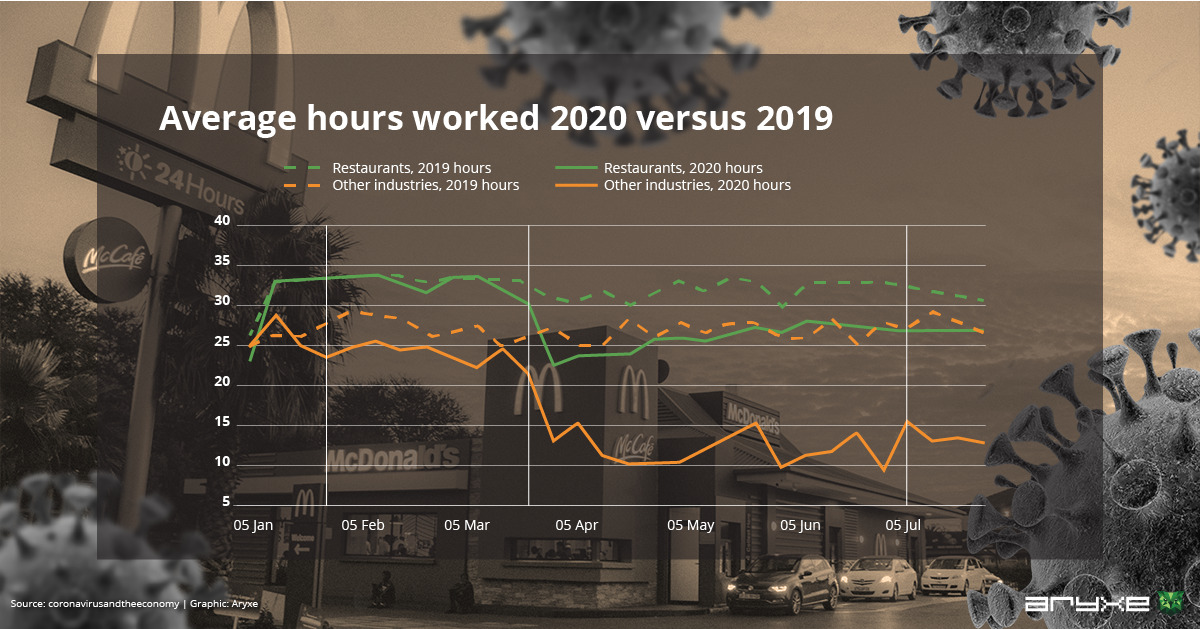
The restaurant industry is going through seriously hard times and because of the raging pandemic it is hard to come to grips considering the scale of losses around the world. Before Covid-19, the restaurant industry was a $899 billion industry that contributed 4% to the US GDP. In America, consumers tend to spend close to 50% of their monthly food budget on dining out, or better yet, used to spend this much before Covid-19 that forced them to break the habit. Astounding numbers were showing the rapid change in consumer behavior in the United States after only three weeks of the shelter in place restrictions. Nearly two thirds of the US adults have reduced the frequency of eating out due to the pandemic.
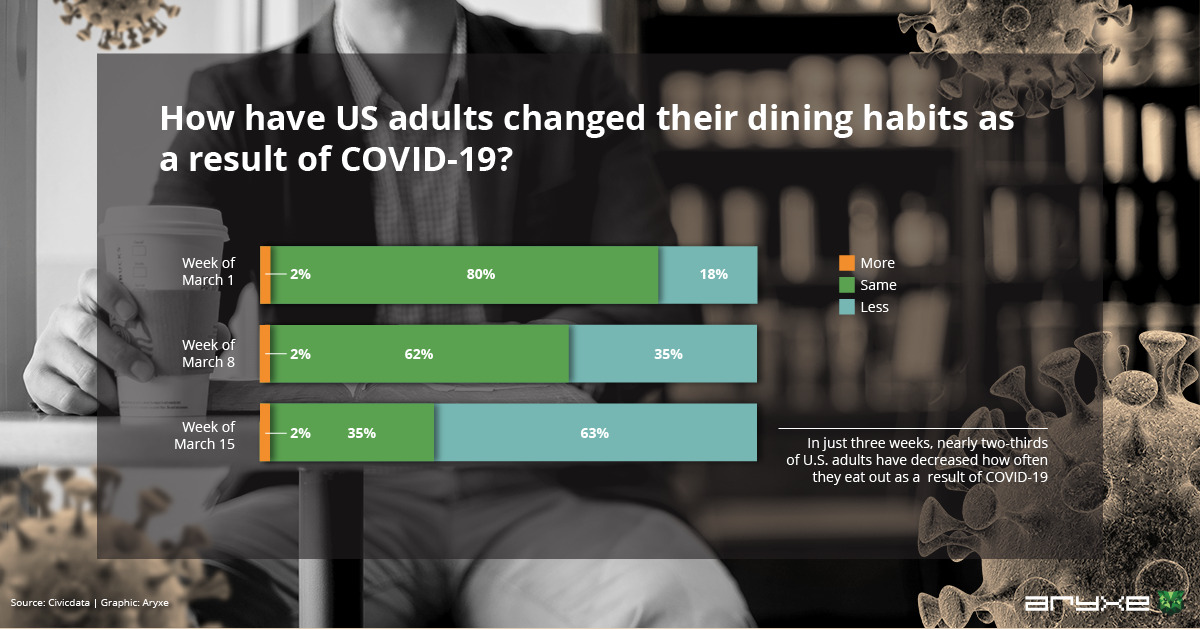
Casual, fast and fine dining places around the world are hecticly reassembling now with a brawling spirit in the wake of the pandemic – completely shifting their focus on takeout and delivery. Still, many are predicting this trend to slowly but steadily decline as people become more wary of food handling risk in the midst of Covid-19. What’s happening right now won’t let restaurant owners make money but the general idea behind it is to keep the food supply running and survive the crisis.
It’s obvious that the pandemic gutted the food industry overall. Thanks to the OpenTable network, we are able to see year-over-year daily change in seated diners due to the coronavirus from February 24th to October 18th, 2020.
Data takes all channels in consideration, including online reservations, phone reservations and walk-ins. For year-on-year comparisons by day, the source compares to the same day of the week from the same week in the previous year. For example, they compare Tuesday of week 11 2020 to Tuesday of week 11 in 2019. Only states or cities with 50+ restaurants in the sample are included. All restaurants on the OpenTable network in either period are included.
OpenTable is active in more than 80 countries, including Australia, Canada, Germany, Ireland, Italy, Japan, Mexico, the Netherlands, Spain, United Kingdom and the United States.
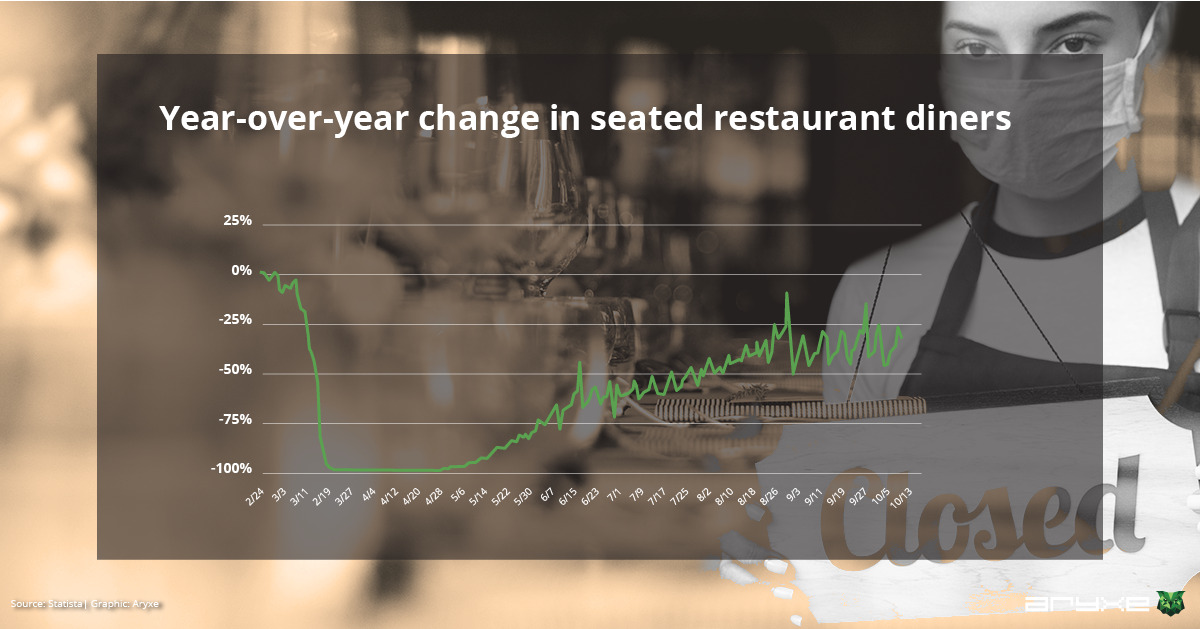
In June, a survey was conducted to see if businesses fear that the virus would come back after the initial wave of lockdowns.
The results are driven by the New England region with 88% responders, 85% of them aged 55-64. The highest number of consumers expressed a concern that the virus will return before the end of the year (which we can now just corroborate). On the other hand, 32% of responders, out of which 31% is aged 18-24, reported that they weren’t really concerned about the second wave.
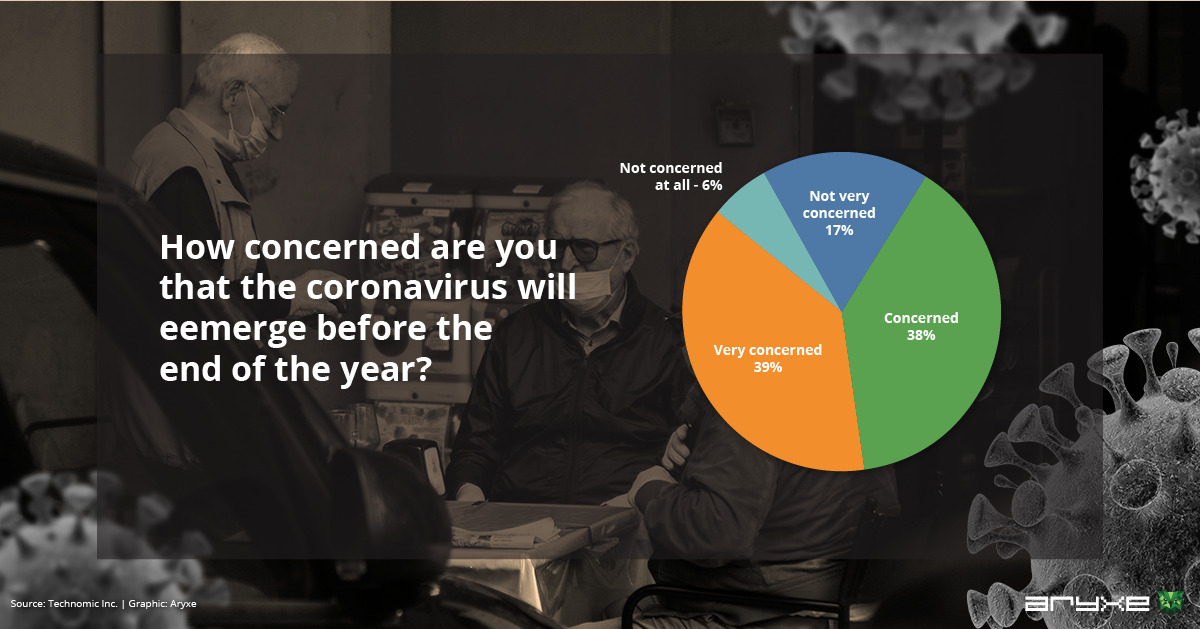
Their survey also shows that concerns for employee health and safety extend to consumers for only 39% of operators, while 33% of them are more worried about adjusting their operation to comply with the new standards and regulations brought by the pandemic.
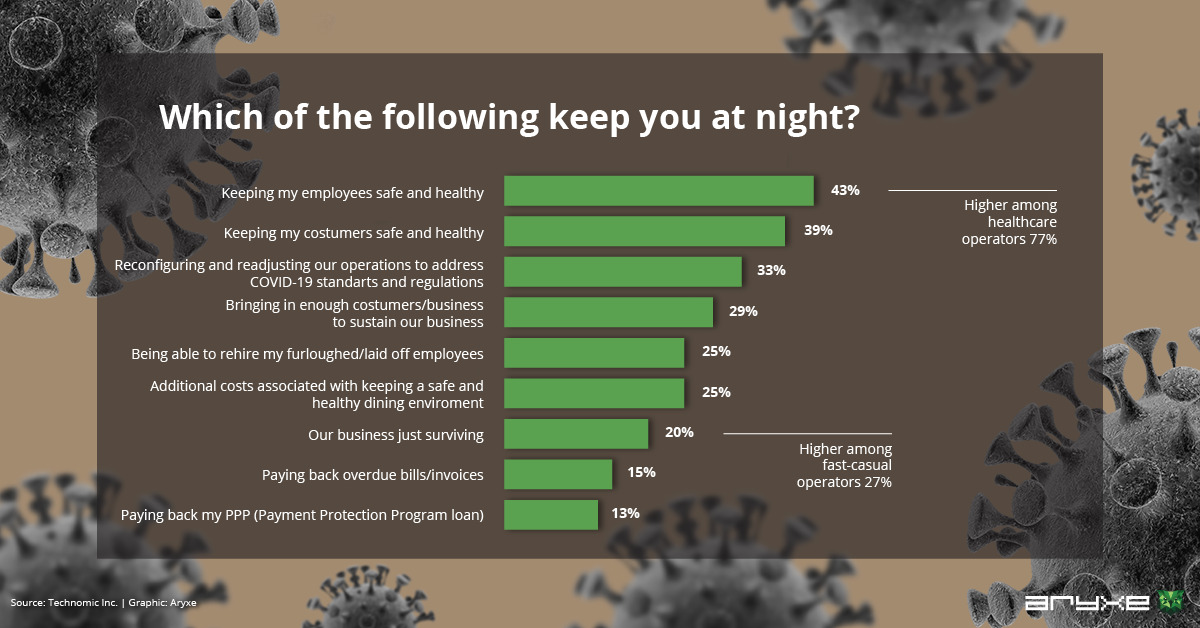
7/10 operators reported a decrease in sales that is less than 20%. Also, two-fifths reported a decrease of less than 10%. All in all, 73% of operators reported a decrease less than 20%, compared to 55% of beyond restaurant operators.
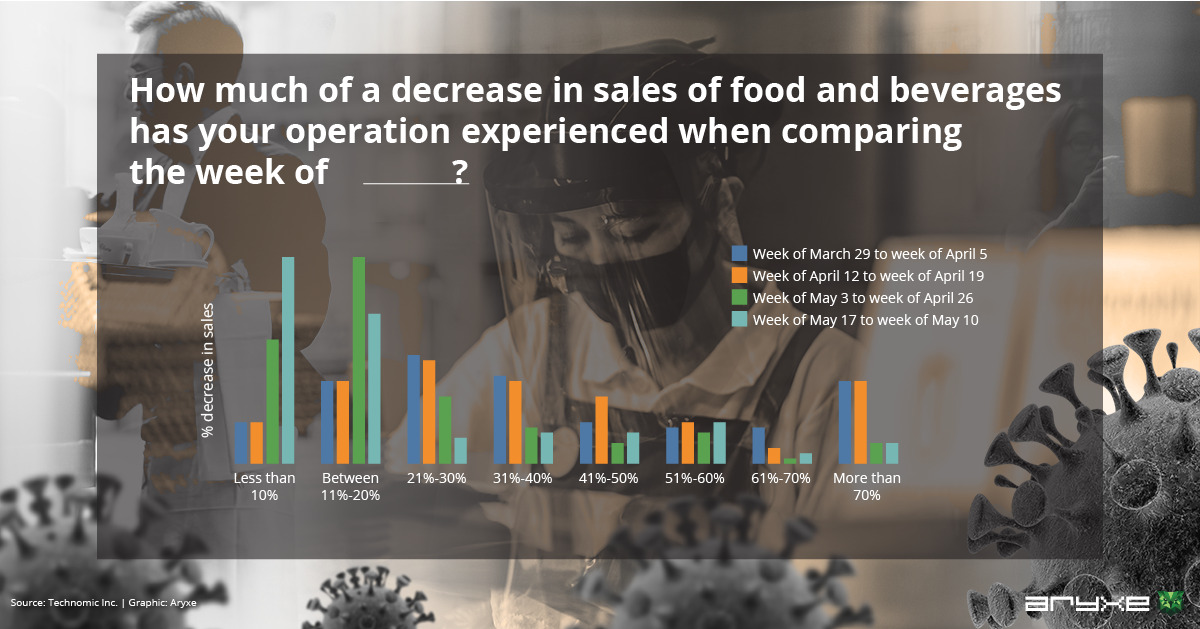
The pandemic has then entered a so-called second wave a while ago. Some were expecting that the number of new cases will plateau, but ever since June, the numbers have doubled! This means that the plans for localized containment to limit future economic damage have already failed.
What seems to aggravate the uncertainty of pandemic is the disinclination of most consumers to go back to dining in at crowded restaurants. Once numbers of infected people start declining, some of that unwillingness will dissipate. Still, some say not all of it will vanish. Another layer to it is all those businesses that went with working remotely, who feel a lot of pressure turning them to prolong their stay-at-home policies. In turn, those decisions will determine how quickly restaurants get back on their feet and return to their pre-pandemic sales levels.
In fact, some businesses may very well shift to remote work permanently, which will affect the restaurants that heavily rely on occasions such as lunch breaks in business centers.
Innovations in how restaurants operate have resulted in creation of new roles and new tech solutions
Risk mitigation has been a trendy topic for weeks, shedding light on the new operational roles both at the unit level and within technologically enhanced ordering systems. Some of those roles are concierges acting as greeters, bouncers and traffic cops. A concierges’ job right now is to control the flow of foot traffic and queuing systems in order to ensure physical distancing guidelines are met. There are enhanced janitorial duties as well now, so sanitations specialists are focused on keeping surfaces squeaky clean throughout operational periods. Finally, apps to order food and facilitate touchless transactions have made their way to the market, which may stick even after the pandemic decides to leave us be.
What are consumers thinking about the future of restaurants?
About half of consumers don’t expect restaurants to charge extra, approximately one third of them would be okay with raised menu prices or included surcharge. Still, one third of respondents stated that they would actually choose a different restaurant if prices were any higher than usual. Overall, if restaurants can’t afford to absorb costs, it looks like a surcharge would be more acceptable than increased menu prices.
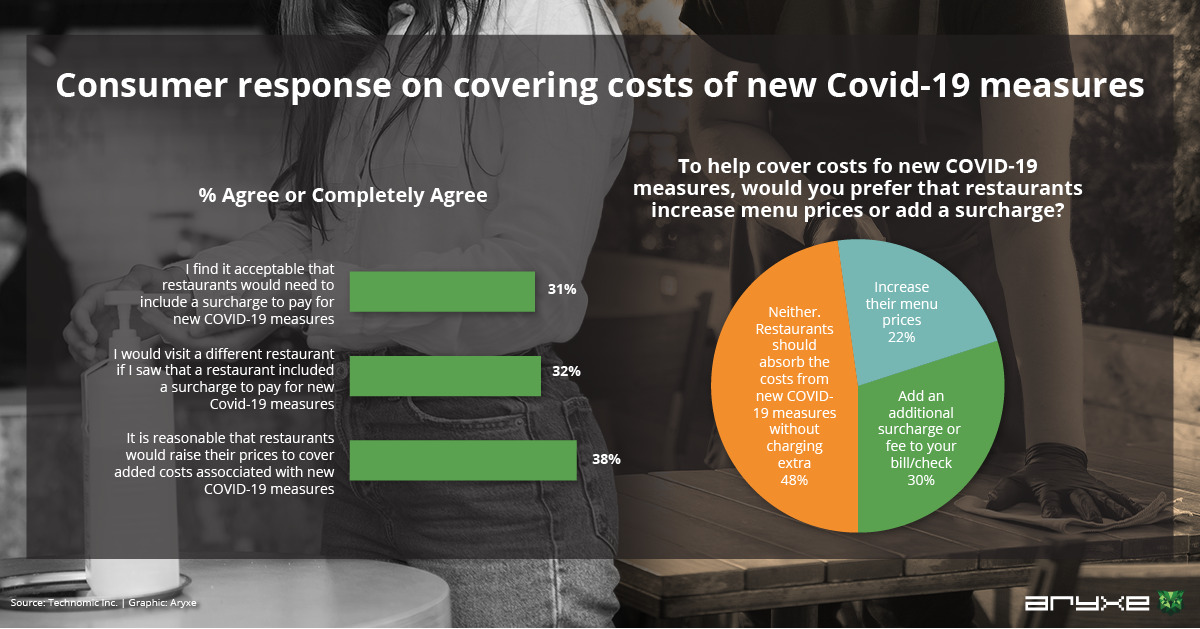
The industry is facing substantial losses in 2020
The degree of losses will largely depend upon the time when restaurant closure restrictions are lifted. If and when we get back to what we once called normal, the experts will be able to grasp the entirety of declines in this industry.
Going digital
The online delivery world has already been on the rise before the pandemic. Now, a shift that was projected to take years is unraveling in a sped up version, just a couple of months. Nearly 3 years of consumer spending is being pulled forward, led by a hastened growth from delivery platforms. The usage of these platforms, commonly referred to as third-party delivery, has surged all thanks to an increase in mobile app orders.
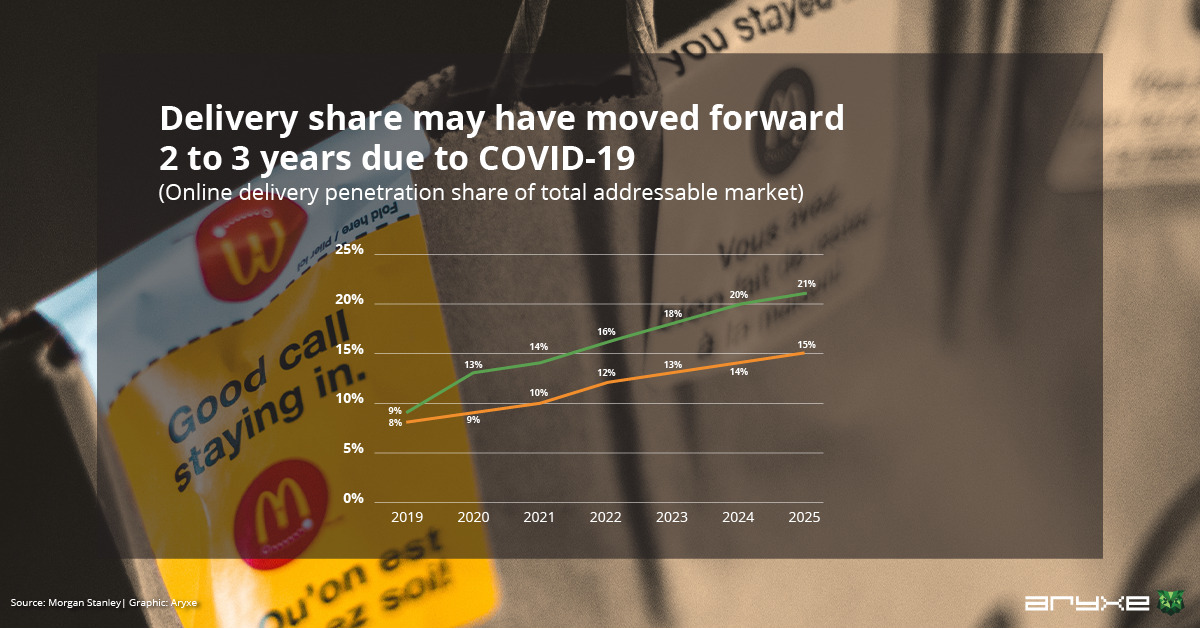
Recovery Plan
According to the National Restaurant Association, the restaurant industry has suffered more than a lot of other industries world-wide. Both sales and job losses were and still continue being the industries 2020 theme song. Over 8 million restaurant employees ended up being laid off or furloughed. And, on top of that, the industry also lost over $200 billion in sales between March and October, 2020.
What can you as a restaurant owner do?
To put it simply, restaurants are going through unprecedented times and there are some that may not make it to the end of the pandemic.
Still, in an attempt to encourage restaurant owners and their staff, we shall share some mitigation strategies.
Now is the time for you to start communicating and being very vocal about off-premise options. Even if you haven’t been thrilled with third party delivery before pandemic, it may be your best chance to get out of the crisis and go back to work. Your consumers need to find a way to receive your product – so, since many don’t feel safe coming to you – go to them! We understand that, in normal circumstances, restaurants prefer people to order less and come dine in more. However, in this time of crisis, any business is good business, so you shouldn’t skip on partnering up with some third party delivery options.
In case someone in your staff is exposed to Covid-19 – don’t hide it! Instead, go with what CDC recommended – notify the workers and make sure they are all aware of it, notify your consumers. Slow things down until you are certain that you can go back to providing a safe environment for both your customers and your employees.
Their recommendations also note that if your employees are showing flu-like symptoms, they should stay at home until they are symptom free and ready to get back to work.
Everyone knows that restaurants have to follow extremely strict health guidelines. As a matter of fact, restaurants with higher ratings are the most sanitary of public places, thanks to their rigorous safety procedures that they have in place.
This is when everyone needs to step up their sanitation game by increasing the hand-washing protocol, wiping down all equipment and appliances, thoroughly cleaning all high touch surfaces and making sure staff or guests are not coming in sick. You need to be extremely vocal about the importance of everyone’s health and safety.
Final Thoughts
These last few months have been tough on the restaurant industry, but not only! We’re keeping our hopes up and counting on every restaurant operator to follow strict sanitation guidelines, along with making sure their staff and consumers are kept safe and healthy at all times. Focusing on your online presence, being inventive and optimistic is something you must do in order to keep the business going. The restaurant industry has become humongous over time and for a good reason: gathering around a table is a way which connects people very tightly and helps create valuable memories. After the Covid-19 pandemic has gone, which will inevitably happen, people will be wary and cautious. So, it’s on you to ensure they’re responsible and taking their safety and health very seriously and, in turn, your consumers will rejoin you in a try to go back to the normalcy everyone is so thirsty of.
Any reuse, transmission, republication, duplication or distribution of this article and graphics, without the express written permission of Aryxe is not allowed. If you wish to reuse, transmit, republish, duplicate or distribute this article, cite passages or use in full, including but not limited to proprietary text and graphics, please request a written permission.
https://www.restaurantbusinessonline.com/special-reports/timeline-how-todays-restaurant-industry-came-be
https://www.thinkwithgoogle.com/marketing-strategies/search/restaurant-marketing-strategy/
https://www.cuisinenet.com/articles/the-history-of-restaurants/
https://www.technomic.com/technomics-take/coronavirus-foodservice-view
https://www.abccolumbia.com/2020/09/01/impact-of-covid-19-pandemic-on-restaurant-industry/
https://edition.cnn.com/2020/10/21/business/chipotle-delivery-earnings/index.html
https://www.technomic.com/newsroom/after-steady-growth-2019-technomic-predicts-2020-will-be-most-challenging-year
https://www.technomic.com/technomics-take/coronavirus-foodservice-view
https://www.technomic.com/newsroom/technomic-revises-foodservice-industry-forecasts-reflecting-sales-growth-21-2021
https://www.technomic.com/newsroom/post-pandemic-playbook
https://www.morganstanley.com/ideas/coronavirus-restaurant-trends
https://www.deccanherald.com/business/business-news/the-future-of-restaurants-in-the-post-covid-19-era-846870.html
https://www.qsrmagazine.com/outside-insights/13-things-could-change-restaurants-after-covid-19
https://www.restaurantbusinessonline.com/technology/touchless-technology-future-restaurants
https://www.deccanherald.com/business/business-news/the-future-of-restaurants-in-the-post-covid-19-era-846870.html
https://www.qsrmagazine.com/outside-insights/13-things-could-change-restaurants-after-covid-19
https://rallyforrestaurants.com/impact-COVID-19-restaurant-insights.html
https://www.wearemiq.com/blog/the-impact-of-covid-19-on-eating-restaurants-and-fast-food-chains/
https://restaurant.org/manage-my-restaurant/business-operations/covid19/recovery
https://www.enderuncolleges.com/news/what-is-the-future-of-restaurants-in-this-covid-19-era-heres-what-the-industry-experts-think/
https://www.wspa.com/news/local-news/winter-and-covid-19-forces-restaurants-to-make-outdoor-seating-game-plan/
https://www.restaurantbusinessonline.com/operations/what-should-restaurants-do-during-coronavirus-pandemic
https://pos.toasttab.com/resources/how-to-manage-a-restaurant-during-coronavirus
https://www.qsrmagazine.com/consumer-trends/covid-19s-impact-perspective-restaurant-owners
You are currently viewing a placeholder content from Default. To access the actual content, click the button below. Please note that doing so will share data with third-party providers.
More InformationInput your email to get the latest news in your inbox. We promise not to spam.